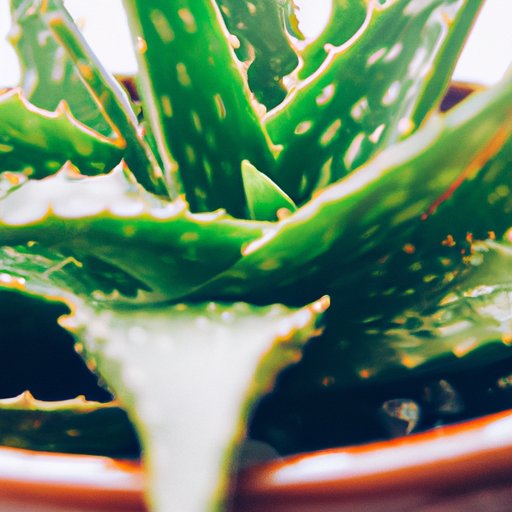
Introduction: The Popularity and Purpose of Aloe Plants
Aloe plants are a popular succulent that can be found in almost every household. These plants are loved by many people for their ease of care, health benefits, and attractive appearance. Not to mention, aloe plants are versatile and can be used for a variety of purposes, such as soothing minor burns and cuts. In this article, we will discuss how to care for your aloe plant properly to ensure their optimal growth and longevity.
The Benefits of Having an Aloe Plant: How to Care for This Versatile Succulent
Before diving into the details of caring for your aloe plant, it’s important to understand what makes them such a desirable plant for many households. Aloe plants are known for their health benefits, having a gel-like substance in their leaves that is high in vitamins, antioxidants, and antibacterial properties, which can be used on minor cuts and infections. They also require low maintenance and are easy to grow, even in areas with low natural light levels.
When it comes to caring for your aloe plant, it’s essential to keep them in the right growing conditions. These plants grow best in bright, indirect sunlight to avoid any leaf damage from direct sunlight. They also require well-draining soil that is not overly moist so that they do not develop root rot. Watering should be done when the soil is dry to the touch, and no more than once a week.
Green Thumb 101: A Beginner’s Guide to Caring for Your Aloe Plant
If you’re a beginner and new to caring for plants, there are a few things to keep in mind when purchasing and caring for your aloe plant. When selecting a container, choose one with drainage holes to allow excess water to drain out. It is also crucial to choose the right type of soil. Aloe plants require soil that is well-draining and not too moisture retentive.
When choosing the perfect spot for your plant, make sure it’s in a location where it will receive plenty of bright, indirect sunlight. Because aloe plants are susceptible to cold temperatures, they should be kept in warm environments, such as near a window or under a grow light.
From Sunlight to Soil: Tips and Tricks for Aloe Plant Care and Maintenance
To maintain happy and healthy growth, aloe plants will require regular care and maintenance. One of the most important aspects is watering frequency. It’s essential to avoid overwatering your aloe plant to prevent root rot, which can cause irreversible damage to the plant. A good rule of thumb is to wait until the soil dries out before watering.
Pruning and propagation are also necessary steps in caring for your aloe plant. Aloe plants can propagate themselves through offsets, so you can separate these and plant them in a different container to grow new plants. Pruning should be carried out periodically to ensure the plant is growing healthily and to control its shape and size.
5 Essential Steps to Keeping Your Aloe Plant Happy and Healthy
Here are five essential steps you can take to keep your aloe plant healthy:
- Water your plant when the soil dries out (about once a week).
- Place your plant near bright, indirect sunlight.
- Use a well-draining potting soil and container with drainage holes.
- Feed your plant once a month with a low-nitrogen fertilizer diluted to half-strength.
- Choose a warm and non-drafty location for your plant, such as near a window.
The Dos and Don’ts of Aloe Plant Care: What You Need to Know
When it comes to caring for your aloe plant, there are some dos and don’ts you should follow:
- Do not overwater your aloe plant- this can lead to root rot.
- Use a well-draining soil mix to ensure that the soil is not at risk of becoming waterlogged.
- Avoid placing your aloe plant in direct sunlight to avoid leaf burn.
- Make sure to keep your aloe plant warm and in a draft-free location.
- Fertilize once a month, but make sure you dilute the fertilizer to half-strength to avoid root burn.
A Comprehensive Guide to Aloe Plant Care: Troubleshooting Common Issues and Maximizing Growth
Despite being low maintenance, aloe plants can run into some common issues that should be addressed promptly. For example, if you notice the leaves turning yellow, this could be a sign of overwatering. Additionally, pests such as mealybugs and spider mites may infect the plant, requiring treatment before it spreads. Monitor your plants regularly to ensure you catch any issues early so that they can be addressed promptly to avoid further complications.
Overall, one of the essential things to keep in mind when caring for your aloe plant is to make sure they grow in the correct conditions. Once you have provided the right space, light, water, and soil requirements, looking after your plant is easy. Remember to handle and prune it regularly. By providing proper care and maintenance, you can keep your aloe plant happy, healthy, and thriving.
Conclusion
Aloe plants are an essential plant for any household, providing a range of health and aesthetic benefits, and requiring minimal maintenance to grow. To maintain a healthy and happy plant, remember to select the right soil, the perfect container, and place it in the optimal light exposure. You also should monitor watering frequency, prune, and propagate to keep the plant’s growth in check. By following this comprehensive guide, any beginner can learn how to grow healthy and stable aloe plants with ease.





